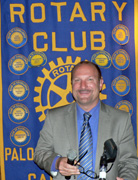Augie Bezmalinovich - Port of LA

Augie Bezmalinovich grew up in San Pedro and graduated from USC with a degree in Computer Science. However, he is now the Community Affairs Advocate for the Port of Los Angeles.
He showed a map and many aerial and ground photos of the San Pedro waterfront area of Los Angeles, starting with old historical photos and progressing to the current pre-and post-development structures and landscaping. One in 7 jobs in the area is linked to port activity.
The original port and its connecting railroad were begun by Phineas Banning 1½ centuries ago (he now has a statue there). Croatian and Italian fishermen found the Mediterranean climate similar to their homelands and made their homes there, establishing the local fishing industry. The Star-Kist Cannery had many women workers processing the fish before the advent of automated machinery and then the collapse of the tuna fish stocks. Old cargo unloading was done mostly by hand. During World War II, military ships and land-based activities at Fort MacArthur dominated the port area. Boatbuilding employed tens of thousands of people at peak activity.
Now, the Los Angeles Port is the largest container port in the US, but the surrounding industrial facilities have decayed and fallen into disuse. A massive port redevelopment project (Strategic Plan) was released in 2006 but is being continuously improved with community input. The waterfront area is becoming friendlier and more beautiful to attract commercial businesses and visiting tourists, with completion scheduled for 2014.
There is now a 30 acre waterfront park in the Wilmington area, and Harry Bridges Boulevard is now tree-lined. N Gaffey St also has a greenway alongside. A Bellagio fountain is synchronized with music. People are increasingly gathering on the promenade and children are playing in the play-fountain area. Many holiday and community events are being scheduled now. Eventually there will be an 8 mile walk along the waterfront.
The Catalina Express will have a new terminal. There is a new cruise ship facility. The Maritime Museum has a new coat of paint and looks much better. Downtown San Pedro will be closer to the water, with tall ships docking there in 2014. The USS Iowa will be brought in south of the Vincent Thomas Bridge. There will be a new entrance to the Ports o’ Call area with new parking towards the bluff and a walkway along the waterfront; they are looking for a $400 million developer for this area (volunteers welcome!). Some warehouse facilities will be converted to craft shops inside, up to 500 shops within the next 2 years. Other warehouse space will become marine research facilities for USC and UCLA.
Up-to-date information on the port area and the progress of the Strategic Plan is available at www.portoflosangeles.org.